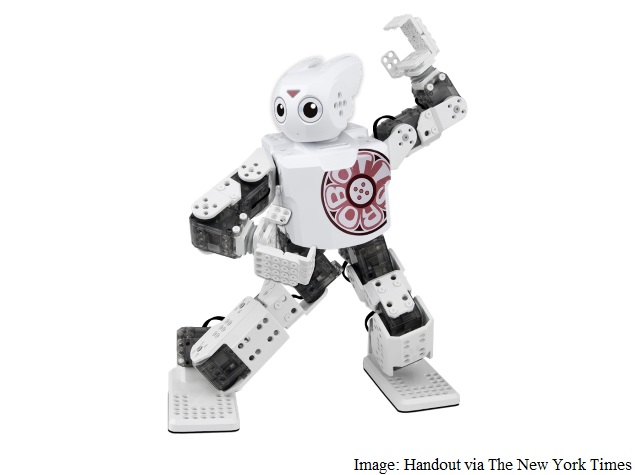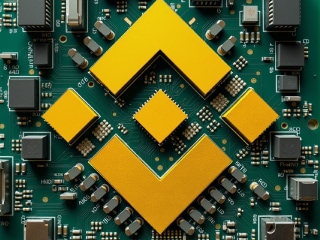- Home
- Science
- Science Features
- The Year in Robots
The Year in Robots

Think washing floors, scrubbing the grill, cutting the lawn, watering plants, changing cat litter, vacuuming the carpet - and, for good measure, pacifying the baby and entertaining the older children.
That was certainly the case at the close of 2013, said Dan Kara, a robotics analyst with ABI Research. "This was supposed to be the year where everything was going to be different," Kara said. "Again."
And while that home-robotics revolution didn't exactly come to fruition this year, Kara said a handful of interesting robotic debuts in 2014 brought consumers one step closer to the chore-free home of the future.
That sentiment was echoed by two others who closely follow the consumer robotics industry: Erico Guizzo, editor of the Automaton blog of the Institute of Electrical and Electronics Engineers, and Andra Keay, managing director of Silicon Valley Robotics, an industry group. Based on recommendations from these specialists, as well as some firsthand tests, here are 10 notable robots that made their debut this year.
Neato Botvac
Vacuums constitute the biggest and most competitive consumer-robotics category in the marketplace, and they're getting better. The earliest models were criticized for their over-reliance on humans to maintain them. ("I had to constantly clean my cleaning robot," Guizzo said.) Owners also had to drag the bots to their charging stations when the batteries died, and move furniture that the robots couldn't squeeze beneath. The Neato Botvac ($480 to $600) requires less cleaning than the earliest robotic vacuums, and it features good pickup power and a low profile that helps it sneak under couches. My favorite feature: When the battery is low, the Botvac returns to its charging station. When Dyson's much-anticipated robot appears next year, watch for similar features.
Grillbot
It's a small, nasty job that's too often forgotten until the food is ready to throw on the barbecue, but cleaning a grill can be a pleasure - as long as someone else is doing it. The $130 Grillbot works like a miniature Roomba, but with more fearsome metal bristles. On a hot or cold grill, start the bot, close the lid and 10 to 30 minutes later, the grate is clean enough to cook on. Some users have noted the bot's tendency to shed bristles, but Ethan Woods, the company's chief executive, said a new design has addressed the issue. Forgetful types will appreciate the device's alarm, which sounds when the bot is left in a hot grill for too long.
Soloshot2
Filming oneself, for fun or work, is easy enough if you stand still. But for less-static pursuits - like sports, dance or just even romping in the yard with your toddler - filming and doing are mutually exclusive. The Soloshot2 is a $400 system made up of a robotic camera harness and a separate sensor that attaches to whatever you want to film. The harness points the camera in the direction of the sensor. With a range of 2,000 feet and a battery life of eight hours for the base and four hours for the sensor, the Soloshot2 can be used to videotape any activity, even your next synchronized swimming session (the sensor is waterproof). The only thing you need worry about is someone stealing your camera while you're playing in the pool.
Litter-Robot
Changing cat litter is the most dreaded entry on my children's list of chores. The Litter-Robot may change that. It's built with a sensor that knows when your cat has visited, and afterward the unit rotates like a giant cement mixer, to sift and deposit clumps into a waste tray. There are downsides: The Litter-Robot is fairly big - about 29 inches high and roughly 25 inches from front to back - so it may not fit easily in smaller apartments. At $389, it's not cheap. And you need to keep it stocked with carbon filters and waste-tray liners.
rockaRoo
A company based in Pittsburgh, 4moms, built the rockaRoo to track a baby's weight and seat position hundreds of times per second, and replicate the rocking motion with a seat that pivots at the bottom. The motion includes "falling at the speed of gravity," the company said, and the motor is quiet enough to allow napping or for the baby to hear whatever music parents wish to play over the device's internal speakers. For parents of colicky or otherwise sleepless babies, this particular bot may be worth the $180 price (roughly Rs. 11,300). For this parent of older kids, it arrived around 12 years too late.
Scooba 450
No company has done more to popularize home robotics than iRobot, the maker of the Roomba vacuum, the Looj gutter cleaner, the Mirra pool cleaner and, this year, the Scooba 450 floor scrubber. The $600 (roughly Rs. 37,800) device soaks the floor, spreads cleaner and scrubs and vacuums the dirty water before a final pass with a squeegee. One hiccup we had during our otherwise successful testing: The "Virtual Wall" accessory, which creates an infrared barrier to keep the Scooba out of specific areas, cast so much infrared light that in smaller spaces the robot was hesitant to scrub anywhere.
Robomow RS
Most household tasks can be blown off with few consequences. Drag your feet on lawn-mowing duties, though, and you pay dearly. Robomow's RS ($1,100 to $2,000) (roughly Rs. 69,300 to Rs.1.2 lakhs) is among the latest entries in a category that's attracting competition from established brands and startups. Setting up the mower can be a chore, as you must map out your yard with wires to define the Robomow's boundaries. Once that's done, though, the bot cuts as often as you like and returns to its charging dock when low on power. It's electric, so noise is less of a problem than with conventional mowers. For American consumers, one big question for Robomow and its competitors is long-term reliability. But analysts give the latest generation of robotic mowers good marks for reliability, and electric mowers generally require none of the annual maintenance faced by owners of gas-powered mowers.
Kibo
The toy market is cluttered with robots that dance and make noise and then, if my children are any indication, collect dust once a child has grown bored with the toy's schtick. Kibo is a different breed of bot, having emerged from a children's technology lab at Tufts University. Designed for ages 4 to 7, it's a learning tool disguised as a toy: Kids program the $230 (roughly Rs. 14,500) robot using wooden blocks that form different commands. Kibo scans the sequence of the blocks and executes the commands, while also reacting to sounds, light and obstacles. Its components are so intuitively designed that a child (or adult) can operate it without reading directions. The idea isn't so much to get kids to understand programming, but rather to use a self-programmed device to enhance playtime activities like storytelling and role playing.
Robotis Mini
Robotis generated much attention for its Robotis-OP humanoid robot, which was praised for its sophistication and versatility, but which carries a $12,000 (roughly Rs. 7.5 lakhs) price tag. This year the company released a miniature version of that device, which loses some of the versatility and durability of its bigger sibling but remains a technological wonder. Unlike the humanoid robot toys on the market, the $500 (roughly Rs. 31,500) Mini is programmable and responds to touch, gesture and voice commands with fluidity and precision. Some owners have complained that putting the robot together is unduly difficult, and the company tacitly acknowledged as much with video tutorials intended to help users through the hourslong assembly process. Another significant drawback, for now, is that you need an Android mobile device running Android software version 4.0 to control the Mini. The cheapest of these are around $150 (roughly Rs. 9,400). An Apple version is in the works, the company said.
Droplet
Gardeners with day jobs and cluttered lives understand that watering plants is a classic problem. You want precise and regular watering; you're more apt to deliver a massive dousing after work and before dinner, and only after the plants have begun tilting earthward for lack of moisture. At $300 (roughly Rs. 18,900), Droplet is a pricey but reliable solution to the problem. Set the sprinkler in place, program the system on a computer or mobile device and connect it to your home's Wi-Fi router, and the system takes over from there. Droplet checks weather data and points the sprinkler to specific pockets of your garden to deliver water where and when it's needed. With a range of 30 feet in all directions, the units can manage bigger gardens and entire swaths of lawn with less wasted water.
© 2014 New York Times News Service
For the latest tech news and reviews, follow Gadgets 360 on X, Facebook, WhatsApp, Threads and Google News. For the latest videos on gadgets and tech, subscribe to our YouTube channel. If you want to know everything about top influencers, follow our in-house Who'sThat360 on Instagram and YouTube.
- Samsung Galaxy Unpacked 2025
- ChatGPT
- Redmi Note 14 Pro+
- iPhone 16
- Apple Vision Pro
- Oneplus 12
- OnePlus Nord CE 3 Lite 5G
- iPhone 13
- Xiaomi 14 Pro
- Oppo Find N3
- Tecno Spark Go (2023)
- Realme V30
- Best Phones Under 25000
- Samsung Galaxy S24 Series
- Cryptocurrency
- iQoo 12
- Samsung Galaxy S24 Ultra
- Giottus
- Samsung Galaxy Z Flip 5
- Apple 'Scary Fast'
- Housefull 5
- GoPro Hero 12 Black Review
- Invincible Season 2
- JioGlass
- HD Ready TV
- Laptop Under 50000
- Smartwatch Under 10000
- Latest Mobile Phones
- Compare Phones
- Oppo K13 5G
- Infinix Note 50s 5G+
- Itel A95 5G
- Samsung Galaxy M56 5G
- HMD 150 Music
- HMD 130 Music
- Honor Power
- Honor GT
- Asus ExpertBook P3 (P3405)
- Asus ExpertBook P1 (P1403)
- Moto Pad 60 Pro
- Samsung Galaxy Tab Active 5 Pro
- Oppo Watch X2 Mini
- Garmin Instinct 3 Solar
- Xiaomi X Pro QLED 2025 (43-Inch)
- Xiaomi X Pro QLED 2025 (55-Inch)
- Nintendo Switch 2
- Sony PlayStation 5 Pro
- Toshiba 1.8 Ton 5 Star Inverter Split AC (RAS-24TKCV5G-INZ / RAS-24TACV5G-INZ)
- Toshiba 1.5 Ton 5 Star Inverter Split AC (RAS-18PKCV2G-IN / RAS-18PACV2G-IN)












